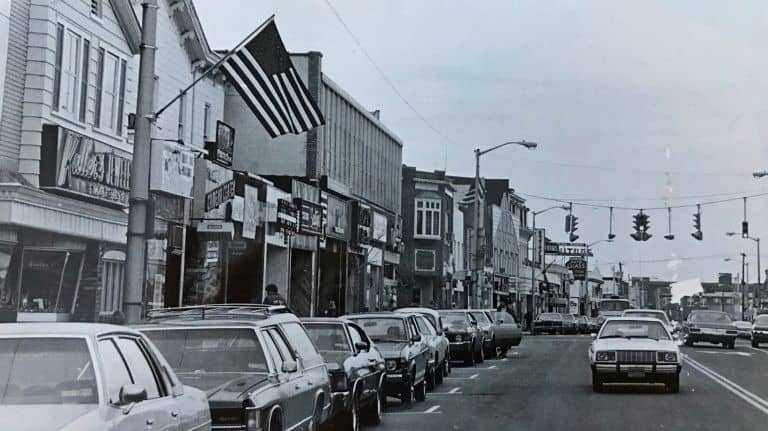The South Shore village can serve as a model for other Long Island communities.
The story of Patchogue began with factories and mills, shipbuilding and fishing. Then the iconic Swezey’s store showed up in the late 1800s and, in the decades that followed, theaters and small shops began to shape the downtown. Decades of growth followed in the village on the Great South Bay.
But by the 1980s, Patchogue had descended into economic decay. A closed theater. Vacant shops. Few signs of life. A place to be avoided.
Now, revival is in full swing. A vibrant theater. Bustling restaurants and retail. Hundreds of new apartments, including where Swezey’s once stood. A place to be.
But Patchogue’s story goes far beyond the tale of how this village became a destination. A study released last week shows in stunning detail the enormous economic impact of the village’s turnaround. It paints a picture of success that other villages and towns across Long Island should seek to learn from and attempt to replicate.

Main Street in Patchogue in 1980, when the village was in decline. Photo Credit: Newsday/ John H. Cornell Jr.
The numbers are staggering. Between 2000 and 2017, even as some parts of the Island remained relatively stagnant, Patchogue saw nearly $700 million in economic activity, and added nearly 6,000 direct and indirect jobs and 54 businesses. Between 2004 and 2017, the village added 211 households from outside the area, and its total population rose. And there’s more to come.
The analysis, commissioned by the Long Island Regional Planning Council, was produced by New Jersey consultant Todd Poole of 4ward Planning, which analyzes past and future development efforts, and assists with planning.
Patchogue, according to Poole, was an unusual project because he typically deals with communities that need help. In Patchogue, he found a community in the midst of tremendous growth that can act as a model.
The recipe isn’t the same for every community, of course. Patchogue started with a renovation of its theater, one of the village’s centerpieces. It had the right infrastructure, particularly a train station, to build around. Also important, it had sewers. But Patchogue needed to upgrade its wastewater treatment plant and expand its sewer system, which otherwise would have been unable to handle the village’s expansion. And the village improved its streetscapes, waterfront and parks.
At the heart of Patchogue’s growth: a willingness from business,civic and political leaders to work together to turn ideas into reality, work with developers and make the math work. Often, that meant seeking public and private grants, including tax breaks. From 1998 through 2017, Patchogue secured more than $37 million in grants, public investment, incentives and loans.Without those funds, the village likely wouldn’t have seen the rise of multi-family residential projects like Artspace Lofts, a 45-unit rental development; Copper Beech, an 80-townhome project; or New Village, with its 291 rental units.
It’s typical for communities to reject tax breaks, or, similarly, payments in lieu of taxes, when developers seek them. It’s also typical for those same communities to assume a negative impact on local schools from new development.
But Patchogue’s results show the opposite. Over a decade, seven key residential projects generated more than $6.6 million in new tax revenue for the school district, even with a variety of incentives and breaks provided. What’s more, that revenue far outpaced the estimated maximum of $3.5 million in costs to the school district generated from an estimated 142 new students. Then there was a domino effect. As businesses and jobs were created, more spending occurred, and more developers wanted to be a part of it. Success generated success.
That doesn’t mean every tax break or every deal should be approved. Some caution is welcome, and community involvement is always necessary and should be encouraged at every stage. But reflexive government and community rejections of requested county and town subsidies, assumptions about negative impacts on schools, and the automatic “no” aren’t helpful. Patchogue shows what can work.
Patchogue’s success isn’t without caveats. There are concerns about parking, and the need for a more diverse mix of businesses. There’s a worry that Patchogue workers will be priced out as home values rise, so more affordable and workforce housing is necessary. There will be a need for further sewer expansion to include more residential properties. And there’s a warning: The village must not get complacent, especially as others follow its lead and compete for visitors, residents and businesses.
Certainly, there are other success stories in the works on Long Island, and villages and hamlets from Amityville to Lindenhurst, from Port Jefferson to Sayville, can use the Patchogue report as evidence and guidance. A good start might be for village mayors and town supervisors to read the 130-page report.
Of course, not everything about Patchogue can be copied or quantified. The most important factor in Patchogue’s revival can’t be cloned, no matter how much regional advocates wish it so. That’s village Mayor Paul Pontieri, first elected in 2004. His vigor, courage and willingness to keep trying are unusual for Long Island, where so many leaders back off in the face of community opposition or hesitate to push past roadblocks. His ability to work with developers, investors and others is rare. In an interview, he told the Newsday editorial board, “You say yes to everything, and then you find a way to make it work.”
Replicating that philosophy is a good place to start.
By The Editorial Board Updated December 8, 2018 6:00 AM


